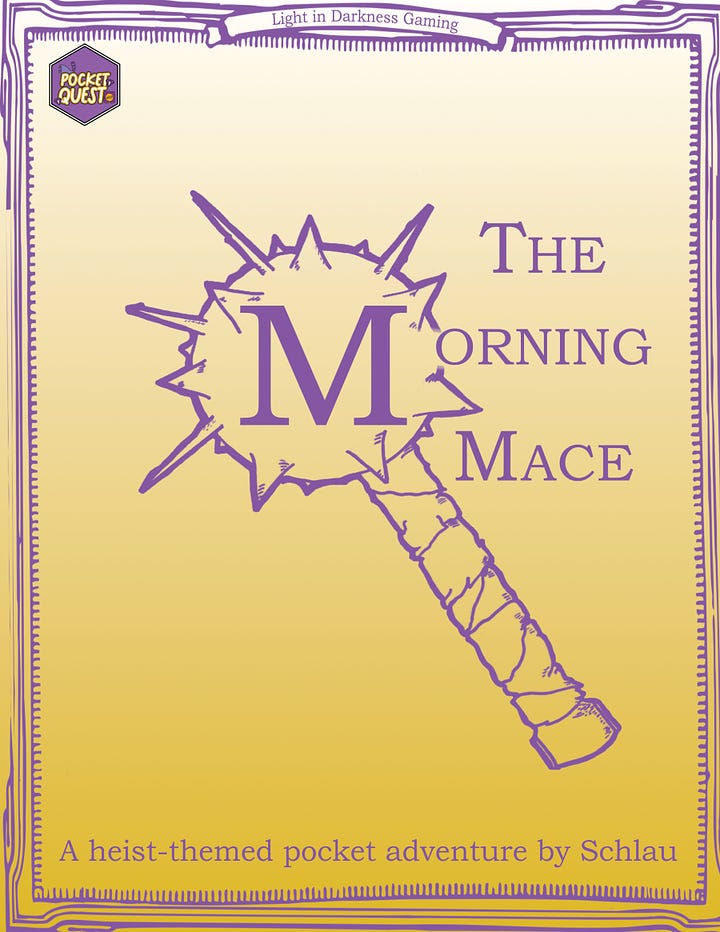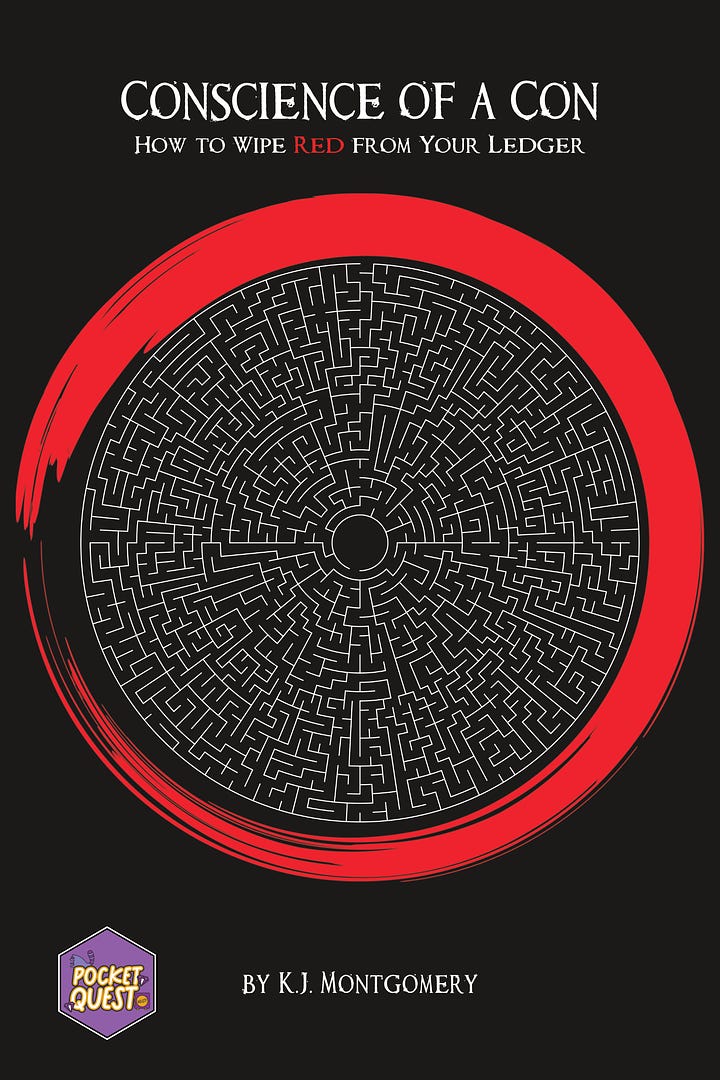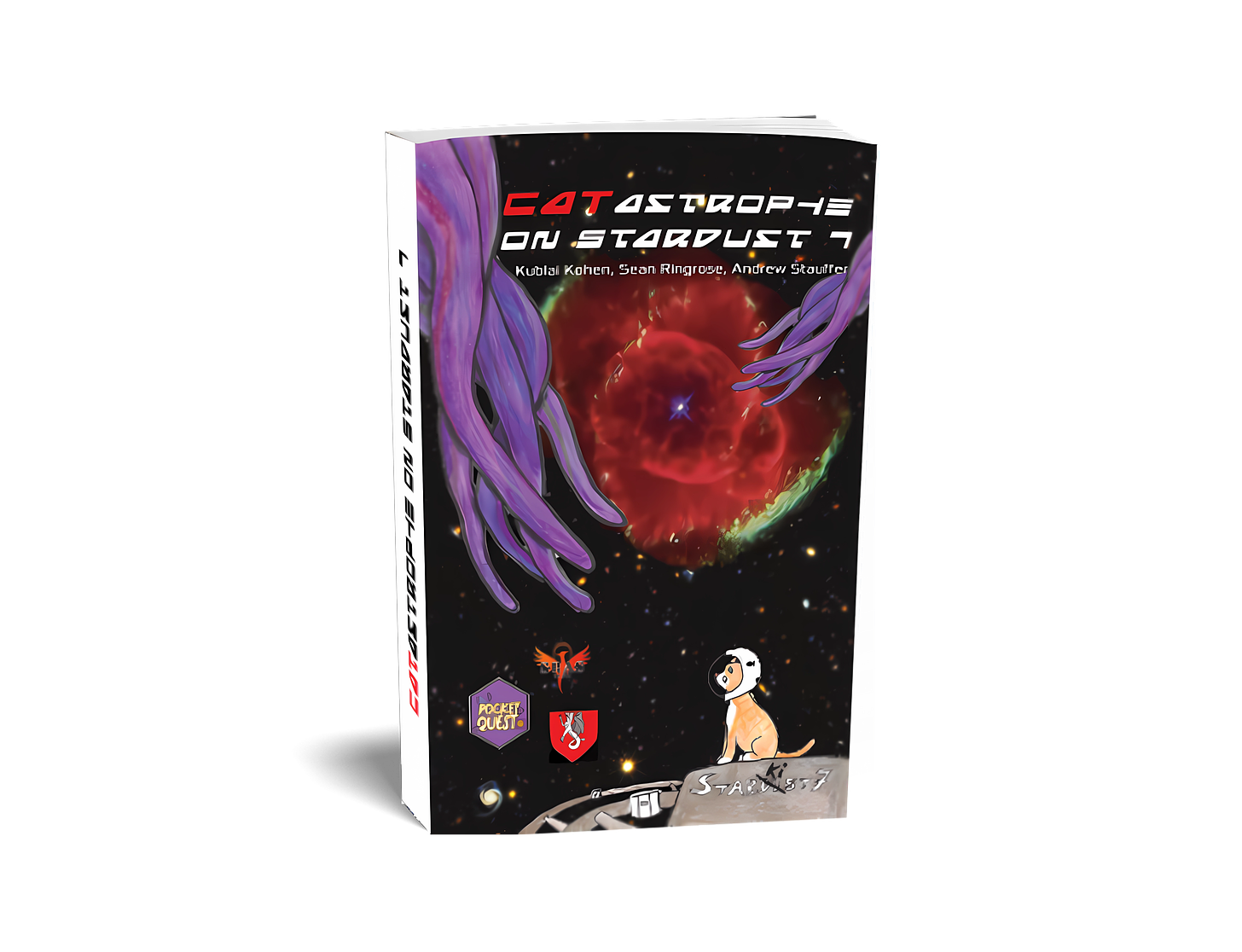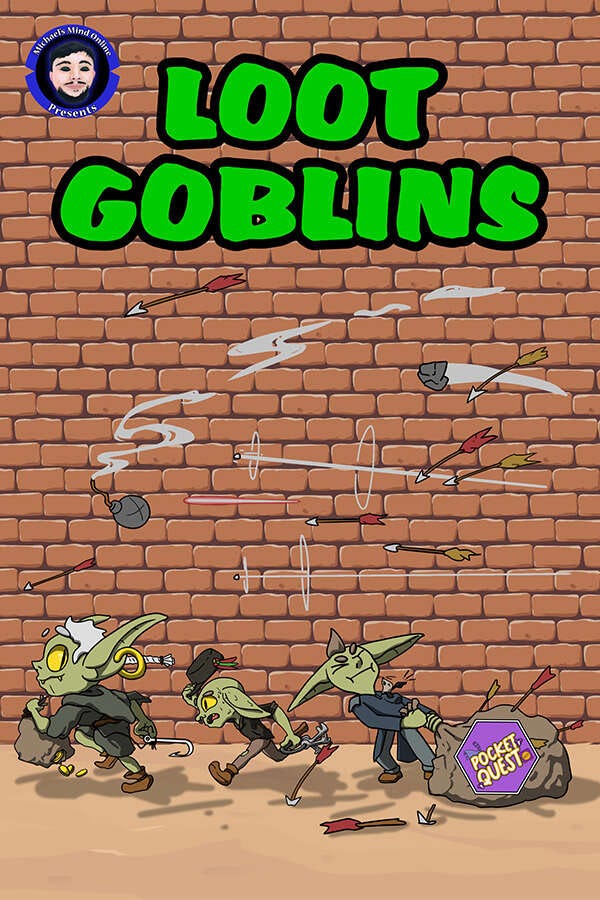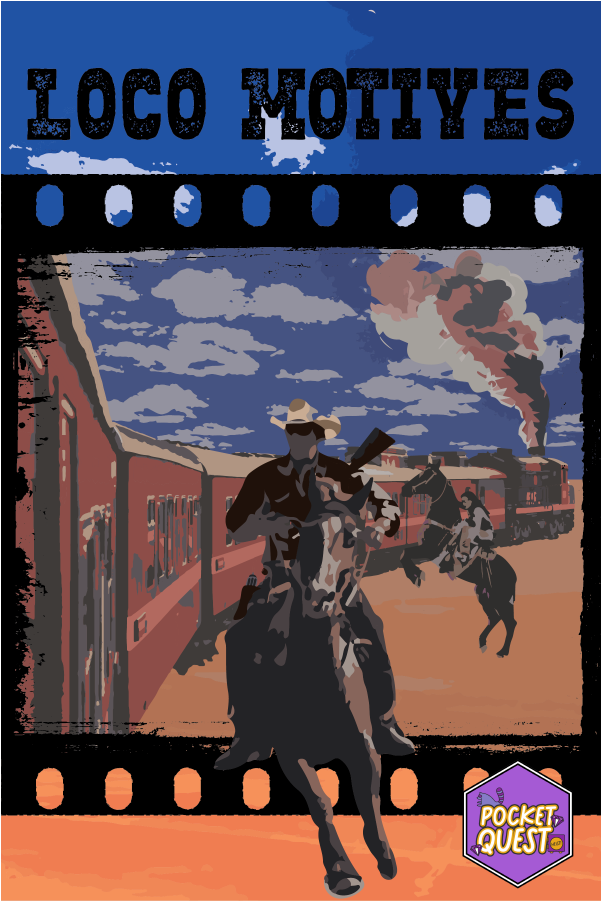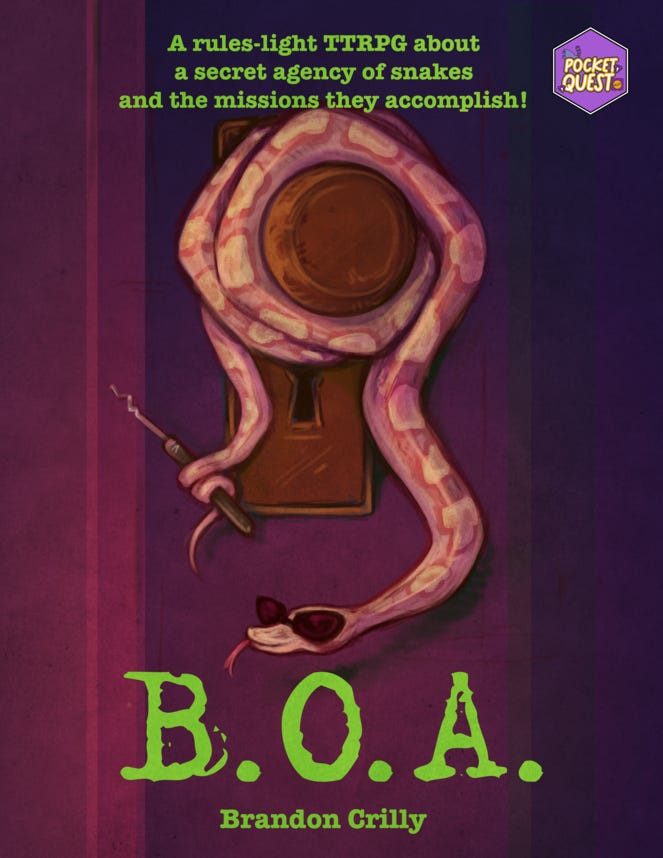In Today’s Issue:
Welcome to the new home for the newsletter (i.e. we’re now on substack)! I’m K.J.* and here’s what we have for you today:
“CATastrophe on Stardust 7” design essay by Kublai Kohen and Andrew Stauffer
“Loot Goblins” design essay by Michael DeBondt
What was it like to play “Loco Motives”?
“Make a game with me” series coming in May
“B.O.A.”: stealthy snakes committing crimes
* I’m K.J.- hobbyist writer, creator, long-time GM, and player who loves supporting others in the RPG community. I also playtest and proofread scenarios. I enjoy playing bass guitar and eating dark chocolate but not at the same time.
I started Watch Well Games at the end of 2023 to build a community around the hobby we have in common - RPGs. Join me as I share about what I learn along the way.
“CATastrophe on Stardust 7” Design Essay
Kublai Kohen and Andrew Stauffer share their thoughts on making “CATastrophe on Stardust 7” - a Pocket Quest game by SRAS games (Sean Ringrose and Andrew Stauffer).
CATastrophe Rising
I was interested in collaborating with someone for this year’s PocketQuest. My projects until now had been solo-written and solo-playable games and it seemed like the former had something to do with the latter. In the days leading up to the start of the jam a lot of us were entertaining ourselves (and the Drive Thru staff, we hoped) by guessing the theme of the jam and coming up with goofy ideas for games. At one point, we got to an idea for a game that involved a ghostly version of the IRS. Don’t ask. Three of us threw some titles around until Sean came up with Undeath and Taxes and I mentioned that I would be glad to collaborate on this.
A couple of weeks later, the jokes centred around cats and Sean got in touch with me to suggest we make a cat-based game. Both of us had ideas for games of our own but promised that we would reserve a bit of bandwidth for this idea. If you look very, very carefully at our two sites, you will notice that neither of us managed to do the individual game that was supposed to be our main focus. I think the collaboration held us responsible for work during a very busy time, divided up the duties to something manageable, and drove our enjoyment of it as we bounced ideas back and forth.
When the Heist theme was announced, Sean and I started thinking seriously. We wanted something that connected to the games we made in the 2023 jam and was family friendly – we liked the idea of creating a web of linked games and, frankly, the larger audience seemed like a good idea. For Sean and Andrew, this was not a problem. Their previous game, Deep Space Crisis, was a lovely setting for a space opera like Babylon 5 or Star Trek: Deep Space 9. My entry was problematic, though. Cthulhu Stardust was a game about Cthulhu waking up on Mars and conquering Earth over five years. It was a little too depressing and gory for family game night.
Still, I came up with a concept that threw together our inspirations – what if the station was near a wormhole, but some accident allowed Cthulhu to come in through it? And what if the only ones able to fight back were the cats on board the station? This fit our goals perfectly. We quickly decided that I would write the setting and the mechanics and then hand it over to Sean for the adventure.
The Mechanics
The game system was very easy to design. Somehow, both of our 2023 games used almost the same mechanics – a dice pool whose base is Attribute+Skill scores. I guess we all played White Wolf games back in the day, or at least Shadowrun. I kept the concept of mutations from my game, where exposure to the Mythos mutates you, making you stronger, but less in control. The approach to the attributes was closer to DSC, dividing actions by your approach to the problem (think/talk/act). Otherwise, I just reworded a few things from the earlier games and cobbled them together.
The Setting
I like a rich setting for games. Nothing so detailed that it forces the players onto a narrow path of play, but something that will let them exist in a brand-new world even as they read the rulebook. With the idea of a cat-based game, I just pulled out all the stops on the ‘silly ideas’ channel in my mind and let loose.
While writing, we discussed where we could find art for the game. I made a couple of rough sketches for mutated cats – one with a scorpion tail and another levitating an eyeball – and realized that we pretty much needed to go with them. The overriding principle became clear for us: cute, but disturbing.
The Layout (by Andrew Stauffer)
The 6”x9” format is a different amount of space than I usually work with, but it was worth it to be included in the omnibus print edition. Sometimes adding in an extra constraint makes for an interesting challenge.
Fitting content to the page without oddly hanging bits, huge empty spaces, or odd line spacing is part of it.
Certain details make the final layout look much better. All of the main section headings, the ones that make it into the table of contents, are always at the top of the page, even if that means the preceding page gets extra white space at the end. That extra space can be an opportunity to add more, or bigger art. The mix of hand-drawn art and digital graphics adds some fun contrast.
You know you’ve done something well when you show it to your collaborators and they point out a detail and call it a brilliant move. The double radio button for skills was a good example. I also loved the frequent cat related puns and jokes, and fitting even more into the text was fun. The first character heading had the letters C A T in character in red. I saw the opportunity to make that same subtle joke in the other headings for character and chapter and the collaborators loved it.
“Loot Goblins” design essay
by Micahel DeBondt
“Loot Goblins” is a Pocket Quest game by Michael DeBondt. It’s available online digitally and in print. Today, Michael shares his thoughts behind making this fun-looking game.
When I joined PocketQuest, I did so with a particular goal: to give the D4 some love. Most people are disappointed in rolling it since its values are so low and limited. But it is the cornerstone of some of my fondest TTRPG memories, so I wanted it to be the heart of the game.
Initially, I began fleshing out a system revolving around the operation of Star Wars-esque starships. D4s would be used as Hit Points for ship systems and checks to make maneuvers.
The idea has been with me for a while, but while building it out, I realized it was going to be too complicated to fit within the allotted 23 pages. Ironically enough, their limited range proved to need a more complicated system in order to facilitate fun.
I still wanted D4s to be a core part of the system, but it needed to supplement a resolution system rather than BE that system. At the same time, the players would need a reason to interact with whatever that supplement was. Otherwise, it’d just be a weird tack-on. That is when the idea of using D4s to represent loot came. If whatever valuables they grabbed during the heist could be used to benefit them DURING the heist, I could balance the scales to make it difficult to succeed without using their loot.
Opting to use the traditional D6 roll high-resolution mechanics, I turned to anydice.com to run probabilities on dice rolls. The range chosen was meant to have players fail 50% of the time, succeed without complication 16% of the time, and succeed if they used a single treasure (adding a D4) 87% of the time. I decided to destroy any loot used to prevent abuse of the system and make players choose if they wanted a bigger payout or to succeed on a check.
The more I built the mechanics, the more I realized this was shaping into a very silly game. A high rate of failure/complication while throwing around valuables in an attempt to prevent the worst outcomes all sounded very goblin-like. Thus, the name Loot Goblins was born, and I had my flavor, well, almost. Initially, the game was meant to be dropped into any setting as a system-neutral game. I had entire equipment lists devoted to providing “heist” gear for different genres like Sci-Fi, Modern, Fantasy, Cowboy, Victorian, etc. But talking to my fellow PocketQuesters made me realize the game should have more of a focused theme. Not only would it help drive future sales, but it would also help players understand how it was meant to be played.
Coming upon that realization, I got a bit depressed since I had fallen in love with making it a genre-breaking game. Then I realized it still could be. If you haven’t watched the lunacy of Time Bandits, you totally should. It’s about a boy accidentally joining a group of dwarves on their journey to steal treasures through time. Replace dwarves with goblins, and my problem became what I think is Loot Goblin’s biggest strength. It let me lean into the chaos and helped me refine elements like the shoddy “goblin tech” equipment, unique class abilities, the ever-growing threat of Time Gnomes, and more fun mechanics.
From the reception of the game during playtesting, I think it was the right move, and I can’t wait to see what others think.
Playing “Loco Motives”
“Loco Motives” is a Pocket Quest game by Dusky Creatives (CJ Weigel, Tobin Risser)
Things we liked:
It’s fun. One player said he liked “doing a heist with two people who liked to use a lot of dynamite and I almost getting blown up.”
It’s narrative and character focused. One player said, “We had a moment at the end where multiple things were going on, snakes were slithering up to a guard, dynamite was being thrown, we had to jump from the moving train. It's fun when the narrative can come together to a critical moment like that.”
Character creation is easy. The players enjoyed the shopping for equipment and gear. I liked the four dice being assigned the the four different character abilities.
The artwork is on point. I grew up watching westerns, so I affirm that the art selection was excellent.
The overall feel and theme to “Loco Motives” is just so good! The names of the abilities and perks are in line with the wild-west theme (buy the game just so you can play a character with Gumption). The creator considered everything, down to the fonts used to evoke a 1800s train heist theme. Brilliant!
Overall, this game has so much potential to be incredibly fun multple times. I especially appreciate that the creator gave three different takes on a train heists (hint: they’re not all traditional wild-west themed - buy the game to find out!)
Things we’d change:
Character descriptions having more weight. One player said: “There could be some prompts for creating "who" your character is. Character creation was mechanical only. Perhaps having players write a few words describing their highest ability.”
Clarify the rules. All four of seemed to agree that the rules regarding betting are a bit muddled. I think the betting mechanic could be done away and the game would be even better. One player felt the game “could've been more high stakes.” (To be fair, I may have as the GM been taking it too easy on my players.) This same player suggested a “little more definition to the abilities, it slows down play when you have to do the mental gymnastics of figuring out what abilities to roll.”
Allow more spacing and remove to breathe in the body of the text.
“B.O.A.”: Stealthy snakes committing crimes
Brandon Crilly created B.O.A. for Pocket Quest 2024. I plan to run a game of this soon for my players and will offer our thoughts on the game in the next newsletter.
“Remain unseen. Accomplish the mission. Promote snake advocacy.
B.O.A. is a rules-light TTRPG about a super-secret agency populated and run entirely by SNAKES. Inspired by games like Honey Heist and Raccoon Sky Pirates, B.O.A. folds everything awesome about these misunderstood creatures into a snake-tastic game of covert ops.” (Source: DriveThruRPG)
I appreciate that Brandon gives us not only a fun game, but one that promotes awareness about snakes by directing us to Advocates for Snake Preservation (ASP). Thanks, Brandon!
Make a game with me
Starting in May, I plan to work on a game. Not that I’m not already work on making a game (actually I’m working on a few). The difference is I want to work on making a game with an audience. It’ll be an experimental experience, where you can participate and give input (I’ll even give you credit and a free copy of the game when it’s done) or just lurk and be amused by my misgivings.
How long will it last? I don’t know, and I think that’s part of the fun. Journeys don’t always have to have a specific deadline.
Our Pocket Quest games
“The Morning Mace” by my cartographer partner Schlau from Light in Darkness Gaming wrote this Pocket Quest game. He plans to release a full version of the rules in the future (along with other adventures). If you like sword and sorcery fantasy, this will scratch that very itch.
“Conscience of a Con: How to Wipe Red From Your Ledger” is my Pocket Quest entry. This is the third game I’ve made so far, and I think it’s the best one yet. If you enjoy solo games, I hope you’ll pick this one up and leave a kind review.
If you already have a copy, please consider sharing the link below with others (and still leave a kind review).
A full version of both of these games will be coming out sometime soon, so watch this space!
Undecided? Here’s some trailers:
